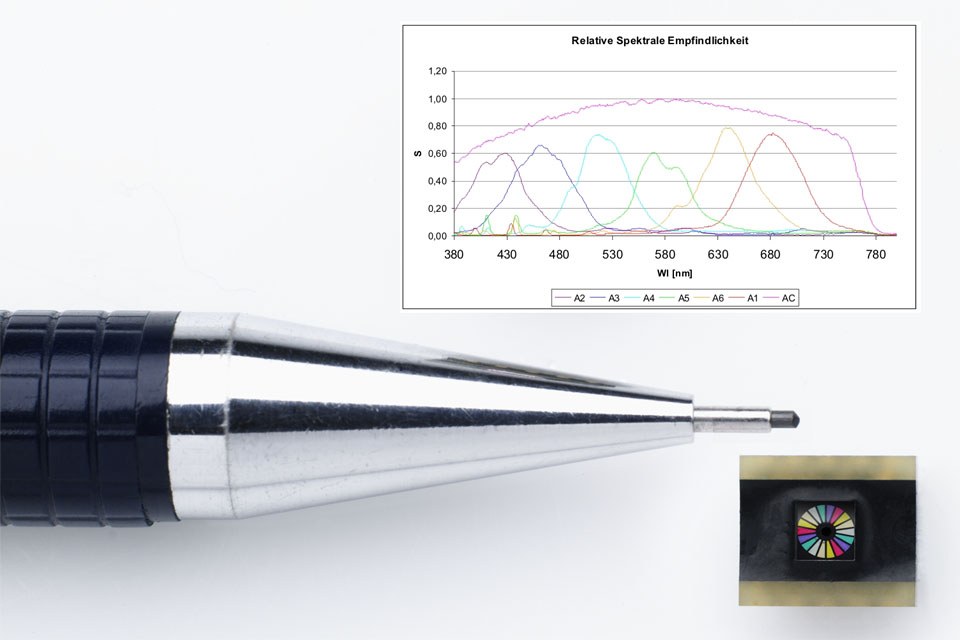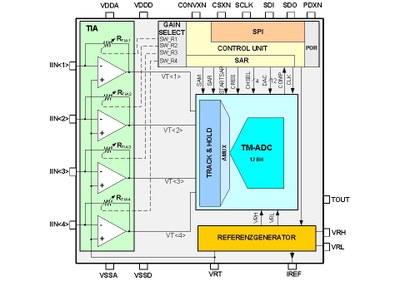MAZeT Released Several New Products - Highlighting MMCS6 Multiple-Color-Sensor, Introduced at electronica 2010
With the principle of a multiple color sensor, MAZeT is pursuing a strategy that bridges the gap between the three-range sensors and spectral measurement devices for sensor applications. The integrated TIAM4 multiple color sensors module, contains the entire sensor electronics on-chip, in addition to the spectral operating detector. The new MDDC 4-channel sensor signal amplifier for sensors with current output, is suitable for fast applications in conjunction with detectors and arrays, such as In-Line (Color) Measurement and control in automated processes. Finally, MAZeT offers also a tool for simulating compact spectrally-selective semiconductor sensors for accurate in-line measurements.
JENCOLOR - Multiple Color Sensorsfor Accurate and Fast In-Line Color Measurement
The multiple color sensor bridges the gap between the three-range sensors and spectral measurement devices for sensor applications. The new MMCS6 product family is based on the proven technologies of the compact and price-to-performance ratio-optimized semiconductor sensors with integrated interference filters. With the MMCS6, a color measurement with seven spectral characteristics in the range of 380 to 780 nm can be taken on the basis of spectral estimation.
The evaluation of a color in this sensor is based not on the colorimetric but on the radiometric level. The initial result is not the chromaticity coordinate but the spectrum of a color, which can be then used to calculate the chromaticity coordinate. The advantages of such measurements lie in the much higher information density in terms of color measurement.
With RGB and true color sensors, MAZeT offers semiconductor-based sensors with RGB or XYZ interference filters for fast and long-term stable color detection and absolute color measurement to the CIE/DIN5033 standard. For these sensors, in connection with white-light LEDs, accuracies in the color space that exceed the capacity of the human eye are possible. The accuracy is very heavily determined by the type of light source and the calibration of the sensors. In applications with non-standard light sources and / or higher standards for color accuracy, the principle of the 3-element color sensors runs up against natural limitations. For such applications, spectral sensor technologies that use a spectral resolution are recommended. Typical examples of these include spectrometers at resolutions such as those used in laboratory measuring instruments but also to some extent as an OEM spectrometer in in-line measurements. For sensor applications, however, such spectrometers are too slow, too expensive and usually too big.
The MMCS6 sensor confers the advantage that the recognition and measurement of metamerism effects can be filtered out, which cannot be done with RGB or XYZ sensors. Metamerism in the optical sense means various spectra that for a defined type of light produce the same impression on the human eye.
The spectral characteristics of the MMCS sensors are arranged in such a way that their border areas overlap. It follows that only as few gaps as possible exist in the visible spectrum. Misleading interpretation of the colors is thus minimized and the measurement accuracy increased. The sensor operates largely independent of the quality of the light sources. Through the spectral approximation of the measured color using MMCS sensors, color differences to which the human eye does not respond can be determined even there.
TIAM4 Multiple Color Sensors On-Chip
A new member of the multiple color sensors is the so-called integrated TIAM4 module. In addition to the spectral operating detector, it contains the entire sensor electronics on-chip. The photocurrents of the detector are converted into voltages and are available via S & H on a MUX on the output side as an analog voltage signal for digital conversion. The TIA-based amplifier is individually programmable in transimpedance over eight levels and is characterized by a very good linearity in the amplifier stages and by low noise.
The TIAM4 is a compact sensor solution that, combined with a suitable light source, is very suitable for fast and/or portable color measuring.
MAZeT offers this new sensor together with an extensive software library for highly accurate and fast color measurement. For initial test measurements, evaluation boards are available that can be optionally integrated in their own test software using DLLs if need be.
With the TIAM4, MAZeT is expanding its family of long-term stable color sensors that can be used even at higher temperatures without drift phenomena.
Multi-Channel Amplifier IC for Fast Digital Power Conversion
The new MDDC 4-channel sensor signal amplifier for sensors with current output converts small input currents quickly and across a high bandwidth and dynamic range and digitizes them on chip via a transimpedance amplifier. Transimpedance amplifiers are preferred in industrial measurement technology for their rapid and cyclic conversion and amplification of the very small currents used in optoelectronic sensors. The ASIC MDDC is suitable for fast applications in conjunction with detectors and arrays, such as In-Line (Color) Measurement and control in automated processes, such as printing and analysis.
The transimpedance (gain) is independently programmable digitally for each channel above 5 bits in 16 stages via the SPI interface. The gradation between the transimpedance per channel is implemented in binary with additional intermediate stages in the range of about 1.6 MΩ to 100MΩ. At the maximum transimpedance, even currents in the nA range can be quickly measured and a dynamic range of 30dB (from 11.7 nA to 2μA; LSB down to 2.8pA) covered. The amplifier stages are characterized by low noise levels and operate with high linearity and synchronism of the channels. Beyond the external programming of the amplifier stages, dynamic in-line amplification on all channels is also available separately in the operation.
The ASIC MDDC includes internally a 12-bit A/D conversion on-chip. The A/D converter basically works as a “successive approximation” A/D converter. Also implemented in the A/D converter is a procedure for temperature modulation, which compensates as far as possible for the large temperature variation in the transimpedance of the current-voltage converter.
The reference programming for the conversion (equivalent to a reference voltage for a conventional A/D voltage converter) can be regulated through the programming of the transimpedance. This is done independently for each channel. Thus, each channel can have its own reference current or current range (Full Scale Range - FSR). All necessary references are implemented internally.
A kind of “Track & Hold” circuit with a four-to-one multiplexer is emplaced before the A/D converter. This implementation allows simultaneous parallel sampling and subsequent serial conversion of the analog values of the channels.
The communication to and from the ASIC is realized through a bi-directional 12-bit SPI interface with a clock up to 16MHz. The SPI clock is used simultaneously for the A/D converter. A conversion time of 1μs per channel and thus a sampling rate of up to 100kS/s for all four channels can be achieved this way.
The MDDC 4-channel current-to-digital converter is very suitable for multi-sensor applications with minimal sensor current. They are typically color sensors and other optical arrays and lines (UV, VIS, NIR, IR-range) in high-speed applications, such as industrial sensors (light grid, length, level, position, thickness and clearance measurement), in dynamic measurement systems for surface analysis (spectral and color measurements, gloss, roughness), temperature measurement (thermal imaging, combustion monitoring) but also with in-line detectors for α-, β-and γ-rays, X-rays and ions.
The ASIC sensors are available in SMD housing or can be ordered as a naked chip for subsequent hybrid or MCM-processing. In connection with the MAZeT True Color Sensors, the amplifiers are available as full color sensor modules or SMD sensor components.
Simulation Tool for Color Measurement Tasks and Regulation of RGBxx LEDs
MAZeT offers a tool for simulating compact spectrally-selective semiconductor sensors for accurate in-line measurements. The system is simulated with the tool starting with the feasibility study and is optimized according to the requirements. Both the selection of the correct sensor and the optimum composition of filters and lighting are achieved in advance with the simulation software to enable the best possible quality for the actual measurement.
Various sensor models for color measurement are provided with the simulation application to cover differing accuracy requirements. The composition can thus be simulated and optimized based on radiometric calculation rules. The simulation tool is suited for the verification of the requirements of new and existing applications. Optimizations can be demonstrated that are easy to implement, such as for example replacing the lighting of the sensor used or the choice of objects for calibration.
The sensor models of the simulation tools are suited to the simple teaching (programming) of RGB and XYZ sensors, to absolute color measurements, to XYZ and multi-range sensors, and radiometric measurements with multi-range sensors. Applications of the light color measurement technology such as the regulation of RGBxx LEDs in colored light sources are also supported. Whatever the task, the optimized composition of filters, lighting and choice of objects for calibration is required to achieve the best possible accuracy.
The spectral composition of the filters and lighting has the strongest impact on the quality of the measurement. While developing the system, the pre-simulation avoids having to make several optimization runs – for example, in the choice of lighting. In addition to saving time, the simulation offers the advantage that during the development it can assess whether all system requirements have been met.




